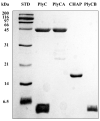Thermal Characterization and Interaction of the Subunits from the Multimeric Bacteriophage Endolysin PlyC
- PMID: 37886987
- PMCID: PMC10604209
- DOI: 10.3390/biology12101277
Thermal Characterization and Interaction of the Subunits from the Multimeric Bacteriophage Endolysin PlyC
Abstract
Bacteriophage endolysins degrade the bacterial peptidoglycan and are considered enzymatic alternatives to small-molecule antibiotics. In particular, the multimeric streptococcal endolysin PlyC has appealing antibacterial properties. However, a comprehensive thermal analysis of PlyC is lacking, which is necessary for evaluating its long-term stability and downstream therapeutic potential. Biochemical and kinetic-based methods were used in combination with differential scanning calorimetry to investigate the structural, kinetic, and thermodynamic stability of PlyC and its various subunits and domains. The PlyC holoenzyme structure is irreversibly compromised due to partial unfolding and aggregation at 46 °C. Unfolding of the catalytic subunit, PlyCA, instigates this event, resulting in the kinetic inactivation of the endolysin. In contrast to PlyCA, the PlyCB octamer (the cell wall-binding domain) is thermostable, denaturing at ~75 °C. The isolation of PlyCA or PlyCB alone altered their thermal properties. Contrary to the holoenzyme, PlyCA alone unfolds uncooperatively and is thermodynamically destabilized, whereas the PlyCB octamer reversibly dissociates into monomers and forms an intermediate state at 74 °C in phosphate-buffered saline with each subunit subsequently denaturing at 92 °C. Adding folded PlyCA to an intermediate state PlyCB, followed by cooling, allowed for in vitro reconstitution of the active holoenzyme.
Keywords: PlyC; antimicrobial; differential scanning calorimetry; endolysin; thermal stability; thermodynamic characterization.
Conflict of interest statement
D.C.N. is a co-inventor of patents related to the PlyC endolysin. The funders had no role in the design of the study; in the collection, analyses, or interpretation of data; in the writing of the manuscript; or in the decision to publish the results.
Figures







Similar articles
-
A new screening method for the directed evolution of thermostable bacteriolytic enzymes.J Vis Exp. 2012 Nov 7;(69):4216. doi: 10.3791/4216. J Vis Exp. 2012. PMID: 23169108 Free PMC article.
-
PlyC: a multimeric bacteriophage lysin.Proc Natl Acad Sci U S A. 2006 Jul 11;103(28):10765-70. doi: 10.1073/pnas.0604521103. Epub 2006 Jul 3. Proc Natl Acad Sci U S A. 2006. PMID: 16818874 Free PMC article.
-
Increasing the stability of the bacteriophage endolysin PlyC using rationale-based FoldX computational modeling.Protein Eng Des Sel. 2015 Apr;28(4):85-92. doi: 10.1093/protein/gzv004. Epub 2015 Mar 3. Protein Eng Des Sel. 2015. PMID: 25740429
-
On the catalytic mechanism of bacteriophage endolysins: Opportunities for engineering.Biochim Biophys Acta Proteins Proteom. 2020 Jan;1868(1):140302. doi: 10.1016/j.bbapap.2019.140302. Epub 2019 Oct 31. Biochim Biophys Acta Proteins Proteom. 2020. PMID: 31678195 Review.
-
A comprehensive review of the applications of bacteriophage-derived endolysins for foodborne bacterial pathogens and food safety: recent advances, challenges, and future perspective.Front Microbiol. 2023 Oct 6;14:1259210. doi: 10.3389/fmicb.2023.1259210. eCollection 2023. Front Microbiol. 2023. PMID: 37869651 Free PMC article. Review.
Cited by
-
Immunogenicity of Endolysin PlyC.Antibiotics (Basel). 2022 Jul 18;11(7):966. doi: 10.3390/antibiotics11070966. Antibiotics (Basel). 2022. PMID: 35884219 Free PMC article.
References
-
- CDC . Antibiotic Resistance Threats in the United States, 2019. U.S. Department of Health and Human Services; Atlanta, GA, USA: 2019.
-
- Ikuta K.S., Swetschinski L.R., Aguilar G.R., Sharara F., Mestrovic T., Gray A.P., Weaver N.D., Wool E.E., Han C., Hayoon A.G., et al. Global mortality associated with 33 bacterial pathogens in 2019: A systematic analysis for the Global Burden of Disease Study 2019. Lancet. 2022;400:2221–2248. doi: 10.1016/S0140-6736(22)02185-7. - DOI - PMC - PubMed
-
- Li Y., Rivers J., Mathis S., Li Z., McGee L., Chochua S., Metcalf B.J., Fleming-Dutra K.E., Nanduri S.A., Beall B. Continued increase of erythromycin nonsusceptibility and clindamycin nonsusceptibility among invasive Group A Streptococci driven by genomic clusters, United States, 2018–2019. Clin. Infect. Dis. 2023;76:e1266–e1269. doi: 10.1093/cid/ciac468. - DOI - PMC - PubMed
Grants and funding
LinkOut - more resources
Full Text Sources

